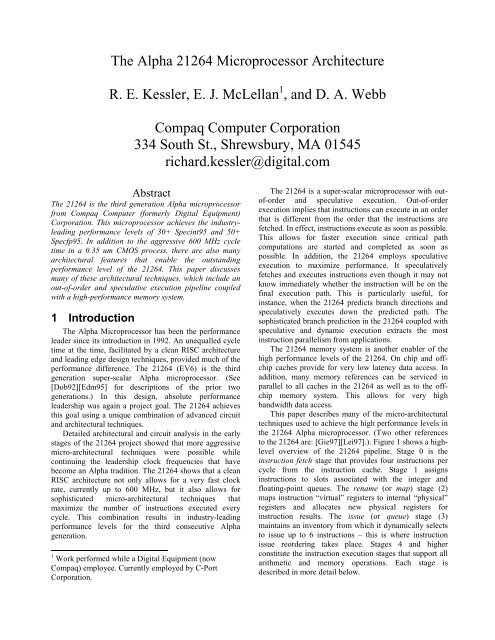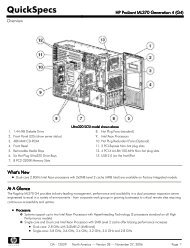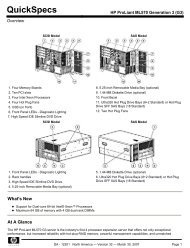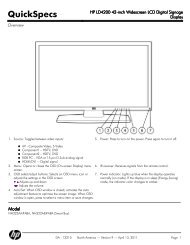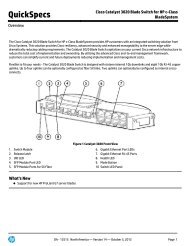The Alpha 21264 Microprocessor Architecture R. E. Kessler, E. J. ...
The Alpha 21264 Microprocessor Architecture R. E. Kessler, E. J. ...
The Alpha 21264 Microprocessor Architecture R. E. Kessler, E. J. ...
You also want an ePaper? Increase the reach of your titles
YUMPU automatically turns print PDFs into web optimized ePapers that Google loves.
<strong>The</strong> <strong>Alpha</strong> <strong>21264</strong> <strong>Microprocessor</strong> <strong>Architecture</strong><br />
R. E. <strong>Kessler</strong>, E. J. McLellan 1 , and D. A. Webb<br />
Compaq Computer Corporation<br />
334 South St., Shrewsbury, MA 01545<br />
richard.kessler@digital.com<br />
Abstract<br />
<strong>The</strong> <strong>21264</strong> is the third generation <strong>Alpha</strong> microprocessor<br />
from Compaq Computer (formerly Digital Equipment)<br />
Corporation. This microprocessor achieves the industryleading<br />
performance levels of 30+ Specint95 and 50+<br />
Specfp95. In addition to the aggressive 600 MHz cycle<br />
time in a 0.35 um CMOS process, there are also many<br />
architectural features that enable the outstanding<br />
performance level of the <strong>21264</strong>. This paper discusses<br />
many of these architectural techniques, which include an<br />
out-of-order and speculative execution pipeline coupled<br />
with a high-performance memory system.<br />
1 Introduction<br />
<strong>The</strong> <strong>Alpha</strong> <strong>Microprocessor</strong> has been the performance<br />
leader since its introduction in 1992. An unequalled cycle<br />
time at the time, facilitated by a clean RISC architecture<br />
and leading edge design techniques, provided much of the<br />
performance difference. <strong>The</strong> <strong>21264</strong> (EV6) is the third<br />
generation super-scalar <strong>Alpha</strong> microprocessor. (See<br />
[Dob92][Edm95] for descriptions of the prior two<br />
generations.) In this design, absolute performance<br />
leadership was again a project goal. <strong>The</strong> <strong>21264</strong> achieves<br />
this goal using a unique combination of advanced circuit<br />
and architectural techniques.<br />
Detailed architectural and circuit analysis in the early<br />
stages of the <strong>21264</strong> project showed that more aggressive<br />
micro-architectural techniques were possible while<br />
continuing the leadership clock frequencies that have<br />
become an <strong>Alpha</strong> tradition. <strong>The</strong> <strong>21264</strong> shows that a clean<br />
RISC architecture not only allows for a very fast clock<br />
rate, currently up to 600 MHz, but it also allows for<br />
sophisticated micro-architectural techniques that<br />
maximize the number of instructions executed every<br />
cycle. This combination results in industry-leading<br />
performance levels for the third consecutive <strong>Alpha</strong><br />
generation.<br />
1 Work performed while a Digital Equipment (now<br />
Compaq) employee. Currently employed by C-Port<br />
Corporation.<br />
<strong>The</strong> <strong>21264</strong> is a super-scalar microprocessor with outof-order<br />
and speculative execution. Out-of-order<br />
execution implies that instructions can execute in an order<br />
that is different from the order that the instructions are<br />
fetched. In effect, instructions execute as soon as possible.<br />
This allows for faster execution since critical path<br />
computations are started and completed as soon as<br />
possible. In addition, the <strong>21264</strong> employs speculative<br />
execution to maximize performance. It speculatively<br />
fetches and executes instructions even though it may not<br />
know immediately whether the instruction will be on the<br />
final execution path. This is particularly useful, for<br />
instance, when the <strong>21264</strong> predicts branch directions and<br />
speculatively executes down the predicted path. <strong>The</strong><br />
sophisticated branch prediction in the <strong>21264</strong> coupled with<br />
speculative and dynamic execution extracts the most<br />
instruction parallelism from applications.<br />
<strong>The</strong> <strong>21264</strong> memory system is another enabler of the<br />
high performance levels of the <strong>21264</strong>. On chip and offchip<br />
caches provide for very low latency data access. In<br />
addition, many memory references can be serviced in<br />
parallel to all caches in the <strong>21264</strong> as well as to the offchip<br />
memory system. This allows for very high<br />
bandwidth data access.<br />
This paper describes many of the micro-architectural<br />
techniques used to achieve the high performance levels in<br />
the <strong>21264</strong> <strong>Alpha</strong> microprocessor. (Two other references<br />
to the <strong>21264</strong> are: [Gie97][Lei97].). Figure 1 shows a highlevel<br />
overview of the <strong>21264</strong> pipeline. Stage 0 is the<br />
instruction fetch stage that provides four instructions per<br />
cycle from the instruction cache. Stage 1 assigns<br />
instructions to slots associated with the integer and<br />
floating-point queues. <strong>The</strong> rename (or map) stage (2)<br />
maps instruction “virtual” registers to internal “physical”<br />
registers and allocates new physical registers for<br />
instruction results. <strong>The</strong> issue (or queue) stage (3)<br />
maintains an inventory from which it dynamically selects<br />
to issue up to 6 instructions – this is where instruction<br />
issue reordering takes place. Stages 4 and higher<br />
constitute the instruction execution stages that support all<br />
arithmetic and memory operations. Each stage is<br />
described in more detail below.
2 Instruction Fetch<br />
<strong>The</strong> instruction fetch stage is the beginning of the<br />
<strong>21264</strong> instruction pipeline. Four instructions are fetched<br />
each cycle to be delivered to the out-of-order execution<br />
engine. <strong>The</strong> <strong>21264</strong> uses many architectural techniques to<br />
provide maximum fetch efficiency. One important enabler<br />
is a large, 64K byte, two-way set-associative instruction<br />
cache. This offers much improved hit rates as compared<br />
to the 8K direct-mapped instruction cache used in the<br />
<strong>Alpha</strong> 21164.<br />
2.1 Line and Set Prediction<br />
<strong>The</strong> <strong>21264</strong> instruction cache implements two-way<br />
associativity via a line and set prediction technique that<br />
combines the speed advantage of a direct-mapped cache<br />
with the lower miss ratio of a two-way set-associative<br />
cache. Each fetch block of four instructions includes a<br />
line and set prediction. This prediction indicates where to<br />
fetch the next block of four instructions from, including<br />
which set (i.e. which of the two choices allowed by twoway<br />
associative cache) should be used. <strong>The</strong>se predictors<br />
are loaded on cache fill and dynamically re-trained when<br />
they are in error. <strong>The</strong> mispredict cost is typically a singlecycle<br />
bubble to re-fetch the needed data. Line and set<br />
prediction is an important speed enhancement since the<br />
mispredict cost is so low and the line/set mispredictions<br />
are rare (the hit rates are typically 85% or higher in<br />
simulated applications/benchmarks).<br />
Branch<br />
Predictor<br />
Integer<br />
Register<br />
Rename<br />
Floating-<br />
Point<br />
Register<br />
Rename<br />
Integer<br />
Issue<br />
Queue<br />
(20<br />
entries)<br />
Floating-<br />
Point<br />
Issue<br />
Queue<br />
(15)<br />
Integer<br />
Reg.<br />
File<br />
(80)<br />
Integer<br />
Reg.<br />
File<br />
(80)<br />
FP<br />
Reg.<br />
File<br />
(72)<br />
In addition to the speed benefits of direct cache<br />
access, there are other benefits that come from line and<br />
set prediction. For example, frequently encountered<br />
predictable branches, such as loop terminators, will avoid<br />
the mis-fetch penalty often associated with a taken<br />
branch. <strong>The</strong> <strong>21264</strong> also trains the line predictor with the<br />
address of jumps that use direct register addressing. Code<br />
using DLL (dynamically linked library) routines will<br />
benefit after the line predictor is trained with the target.<br />
<strong>The</strong> <strong>21264</strong> line predictor does not train on every<br />
mispredict. <strong>The</strong>re is a 2-bit hysteresis associated with<br />
each line that only enables training after the predictor has<br />
been in error several times recently. This avoids some<br />
unnecessary training and misprediction<br />
2.2 Branch Prediction<br />
Another important contributor to fetch efficiency is<br />
branch prediction. <strong>The</strong> <strong>21264</strong> speculative execution<br />
capabilities make branch prediction a more important<br />
contributor to overall performance than with previous<br />
microprocessor generations. Studies show that branch<br />
pattern behavior sometimes correlates with the execution<br />
of a single branch at a unique PC location (i.e. local<br />
history), and pattern behavior sometimes correlates with<br />
execution of all previous branches (i.e. global history).<br />
Both correlation techniques are needed to extract the<br />
maximum branch prediction efficiency.<br />
<strong>The</strong> <strong>21264</strong> implements a sophisticated tournament<br />
branch prediction scheme that dynamically chooses<br />
Fetch Rename Issue Reg Read Execute Memory<br />
0 1 2 3 4 5 6<br />
Line / Set<br />
Prediction<br />
Inst.<br />
Cache<br />
64 KB<br />
2-way<br />
Figure 1 <strong>The</strong> Basic <strong>21264</strong> Pipeline<br />
Integer<br />
Execution<br />
Integer<br />
Execution<br />
Integer<br />
Execution<br />
Integer<br />
Execution<br />
Addr<br />
Addr<br />
Data<br />
Cache<br />
64 KB<br />
2-way<br />
Floating-Point Multiply<br />
Execution<br />
Floating-Point Add<br />
Execution<br />
Level-<br />
Two<br />
Cache<br />
and<br />
System<br />
Interface
Local<br />
History<br />
Table<br />
(1024 x 10)<br />
Program<br />
Counter<br />
Local<br />
Prediction<br />
(1024x3)<br />
Branch<br />
Predicton<br />
Global Prediction<br />
(4096x2)<br />
Choice Prediction<br />
(4096x2)<br />
Path History<br />
Figure 2 <strong>The</strong> <strong>21264</strong> Tournament Branch<br />
Predictor<br />
This figure is a block-diagram of the <strong>21264</strong><br />
branch predictor. <strong>The</strong> local prediction path is on<br />
the left. <strong>The</strong> global prediction path and the<br />
chooser are on the right.<br />
between local and global history to predict the direction<br />
of a given branch [McF93]. <strong>The</strong> result is a branch<br />
predictor that produces a better prediction accuracy than<br />
larger tables of either individual method, 90-100% on<br />
most simulated applications/benchmarks.<br />
Figure 2 shows the structure of the <strong>21264</strong> tournament<br />
branch predictor. <strong>The</strong> local history table holds 10 bits of<br />
branch history for up to 1024 branches, indexed by the<br />
instruction address. <strong>The</strong> <strong>21264</strong> uses the 10-bit local<br />
history to pick from one of 1024 prediction counters. <strong>The</strong><br />
local prediction is the most-significant bit of the<br />
prediction counter. After branches issue and retire the<br />
<strong>21264</strong> inserts the true branch direction in the local history<br />
table and updates the referenced counter (using saturating<br />
addition) to train the correct prediction.<br />
<strong>The</strong> local prediction will be very useful, for example,<br />
with an alternating taken/not-taken sequence from a given<br />
branch. <strong>The</strong> local history of the branch will eventually<br />
resolve to either 1010101010 or 0101010101 (the<br />
alternating pattern of zeroes and ones indicates the<br />
success/failure of the branch on alternate invocations). As<br />
the branch executes multiple times, it will saturate the<br />
prediction counters corresponding to these local history<br />
values and make the prediction correct. Any repeating<br />
pattern of 10 branch invocations can be trained this way.<br />
<strong>The</strong> global predictor is a 4096 entry table of two-bit<br />
saturating counters that is indexed by the global, or path,<br />
history of the last twelve branches. <strong>The</strong> prediction is the<br />
most-significant bit of the indexed prediction counter.<br />
Global history is useful when the outcome of a branch can<br />
be inferred from the direction of previous branches. For<br />
example, if a first branch that checks for a value equal to<br />
ten succeeds, a second branch that checks for the same<br />
value to be even must also always succeed. <strong>The</strong> global<br />
history predictor can learn this pattern with repeated<br />
invocations of the two branches; eventually, the global<br />
prediction counters with indices that have their lowermost<br />
bit set (indicating that the last branch was taken) will<br />
saturate at the correct value. <strong>The</strong> <strong>21264</strong> maintains global<br />
history with a silo of thirteen branch predictions and the<br />
4096 prediction counters. <strong>The</strong> silo is backed up and<br />
corrected on a mispredict. <strong>The</strong> <strong>21264</strong> updates the<br />
referenced global prediction counter when the branch<br />
retires.<br />
<strong>The</strong> <strong>21264</strong> updates the chooser when a branch<br />
instruction retires, just like the local and global prediction<br />
information. <strong>The</strong> chooser array is 4096 two-bit saturating<br />
counters. If the predictions of the local and global<br />
predictor differ, the <strong>21264</strong> updates the selected choice<br />
prediction entry to support the correct predictor.<br />
<strong>The</strong> instruction fetcher forwards speculative<br />
instructions from the predicted path to the execution core<br />
after a branch prediction. <strong>The</strong> <strong>21264</strong> can speculate<br />
through up to 20 branches.<br />
3 Register Renaming and Out-of-<br />
Order Issue<br />
<strong>The</strong> <strong>21264</strong> offers out-of-order efficiencies with much<br />
higher clock speeds than competing designs. This speed,<br />
however, is not accomplished by the restriction of<br />
dynamic execution capabilities. <strong>The</strong> out-of-order issue<br />
logic in the <strong>21264</strong> receives four fetched instructions every<br />
cycle, renames/re-maps the registers to avoid unnecessary<br />
register dependencies, and queues the instructions until<br />
operands and/or functional units become available. It<br />
dynamically issues up to six instructions every cycle -<br />
four integer instructions and two floating-point<br />
instructions.<br />
3.1 Register Renaming<br />
Register renaming assigns a unique storage location<br />
with each write-reference to a register. <strong>The</strong> <strong>21264</strong><br />
speculatively allocates a register to each register-resultproducing<br />
instruction. <strong>The</strong> register only becomes part of<br />
the architectural register state when the instruction<br />
commits/retires. This allows the instruction to<br />
speculatively issue and deposit its result into the register<br />
file before the instruction is committed. Register<br />
renaming also eliminates write-after-write and write-afterread<br />
register dependencies, but preserves all the readafter-write<br />
register dependencies that are necessary for<br />
correct computation. Renaming extracts the maximum<br />
parallelism from an application since only necessary<br />
dependencies are retained and speculative execution is<br />
allowed in the instruction flow.<br />
In addition to the 64 architectural (i.e. softwarevisible)<br />
registers, up to 41 integer and 41 floating point<br />
registers are available to hold speculative results prior to
instruction retirement in a large 80 instruction in-flight<br />
window. This implies that up to 80 instructions can be in<br />
partial states of completion at any time, allowing for<br />
significant execution concurrency and latency hiding.<br />
(Particularly since the memory system can track an<br />
additional 32 in-flight loads and 32 in-flight stores.) <strong>The</strong><br />
<strong>21264</strong> tracks outstanding unretired instructions (and their<br />
associated register map information) so that the machine<br />
architectural state can be preserved in the case of a misspeculation.<br />
3.2 Out-of-Order Issue Queues<br />
<strong>The</strong> issue queue logic maintains a list of pending<br />
instructions. Each cycle the separate integer and floatingpoint<br />
queues select from these instructions as they<br />
become data-ready using register scoreboards based on<br />
the renamed register numbers. <strong>The</strong>se scoreboards<br />
maintain the status of the renamed registers by tracking<br />
the progress of single-cycle, multiple-cycle, and variable<br />
cycle (i.e. memory load) instructions. When functional<br />
unit or load data results become available, the scoreboard<br />
unit notifies all instructions in the queue that require the<br />
register value. <strong>The</strong>se dependent instructions can issue as<br />
soon as the bypass result becomes available from the<br />
functional unit or load. Each queue selects the oldest dataready<br />
and functional-unit-ready instructions for execution<br />
each cycle. <strong>The</strong> 20-entry integer queue can issue four<br />
instructions, and the 15-entry floating-point queue can<br />
issue two instructions per cycle.<br />
<strong>The</strong> <strong>21264</strong> cannot schedule each instruction to any of<br />
the four integer execution pipes. Rather, it statically<br />
assigns instructions to two of the four pipes, either upper<br />
or lower, before they enter the queue. <strong>The</strong> issue queue has<br />
two arbiters that dynamically issue the oldest two queued<br />
instructions each cycle within the upper and lower pipes,<br />
respectively. This static assignment to upper/lower fits<br />
well with the integer execution engine - some functional<br />
units do not exist in both the upper and lower pipelines,<br />
and the dynamic scheduling of the issue queue minimizes<br />
cross-cluster delays. Section 4 discusses this more.<br />
<strong>The</strong> queues issue instructions speculatively. Since<br />
older instructions are given priority over newer<br />
instructions in the queue, speculative issues do not slow<br />
down older, less speculative issues. <strong>The</strong> queue is<br />
collapsing – an entry becomes immediately available once<br />
the instruction issues or is squashed due to misspeculation.<br />
4 Execution Engine<br />
To support the high frequency goals of the project, the<br />
design of the integer register file was a particular<br />
challenge. Typically, all execution units require access to<br />
the register file, making it a single point of access and a<br />
potential bottleneck to processor performance. With as<br />
many as fourteen ports necessary to support four<br />
simultaneous instructions in addition to two outstanding<br />
load operations, it was clear that the register file would be<br />
large and an implementation challenge. Instead, the <strong>21264</strong><br />
splits the file into two clusters that contain duplicates of<br />
the 80-entry register file. Two pipes access a single<br />
register file to form a cluster, and the two clusters are<br />
combined to support 4-way integer instruction execution.<br />
<strong>The</strong> incremental cost of this design is an additional<br />
cycle of latency to broadcast results from each integer<br />
cluster to the other cluster. Performance simulation shows<br />
this cost to be small – a few percent or less performance<br />
difference from an idealized un-clustered implementation<br />
with most applications. <strong>The</strong> integer issue queue<br />
dynamically schedules instructions to minimize the one<br />
cycle cross-cluster communication cost; An instruction<br />
can usually first issue on the same cluster that produces<br />
the result. This architecture provides much of the<br />
implementation simplicity and lower risk of a two-issue<br />
machine with the performance benefits of four-way<br />
integer issue. <strong>The</strong>re are two floating-point execution pipes<br />
organized in a single cluster with a single 72-entry<br />
register file. Figure 3 shows the configuration.<br />
<strong>The</strong> <strong>21264</strong> includes new functionality not present in<br />
prior <strong>Alpha</strong> microprocessors: a fully-pipelined integer<br />
multiply unit, an integer population count and<br />
leading/trailing zero count unit, a floating-point squareroot<br />
functional unit, and instructions to move register<br />
values directly between floating-point and integer<br />
registers. It also provides more complete hardware<br />
support for the IEEE floating-point standard, including<br />
precise exceptions, NaN and infinity processing, and<br />
support for flushing denormal results to zero.<br />
Floating<br />
Point<br />
FP Mult.<br />
72 Reg’s<br />
FP Add<br />
FP Div.<br />
FP SQRT<br />
MVI/PLZ Int. Mult.<br />
Shift/Br Shift/Br<br />
Add/<br />
Logic<br />
80 Reg’s 80 Reg’s<br />
Add/<br />
Logic<br />
Load/<br />
Store<br />
Integer<br />
Cluster 1 Cluster 0<br />
Figure 3 <strong>The</strong> <strong>21264</strong> Execution Pipes<br />
Add/<br />
Logic<br />
Add/<br />
Logic<br />
Load/<br />
Store<br />
This figure shows the four integer execution<br />
pipes (upper and lower for each cluster) and the<br />
two floating-point pipes in the <strong>21264</strong>, together<br />
with the functional units in each.
5 Memory System<br />
<strong>The</strong> memory system in the <strong>21264</strong> is high-bandwidth,<br />
supporting many in-flight memory references and out-oforder<br />
operation. It receives up to two memory operations<br />
(loads or stores) from the integer execution pipes every<br />
cycle. This means that the on-chip 64 KB two-way setassociative<br />
data cache is referenced twice every cycle,<br />
delivering 16 bytes every cycle. In effect, the data cache<br />
operates at twice the frequency of the processor clock.<br />
Since the cache is double-pumped this way there is full<br />
support for two memory references every cycle without<br />
conflict. <strong>The</strong> off-chip (level-two) cache provides a very<br />
fast backup store for the primary caches. This cache is<br />
direct-mapped, shared by both instructions and data, and<br />
can range from 1 to 16 MB. <strong>The</strong> off-chip clock-forwarded<br />
cache interface can support a peak data transfer rate of 16<br />
bytes every 1.5 CPU cycles.<br />
<strong>The</strong> latency of the virtual-indexed on-chip data cache<br />
is three cycles for integer loads and four cycles for<br />
floating-point loads. <strong>The</strong> latency to the physical-indexed<br />
off-chip cache is twelve cycles, depending on the speed of<br />
the cache. <strong>The</strong> <strong>21264</strong> supports many SRAM variants,<br />
including late-write synchronous, PC-style, and dual-data<br />
for very high frequency operation.<br />
<strong>The</strong> <strong>21264</strong> also has a fast interface that allows the<br />
memory system surrounding the microprocessor to<br />
provide data quickly, typically from DRAM, upon a cache<br />
miss. <strong>The</strong> peak bandwidth of the clock-forwarded system<br />
interface is 8 bytes of data per 1.5 CPU cycles.<br />
<strong>The</strong> <strong>21264</strong> memory system supports up to 32 in-flight<br />
loads, 32 in-flight stores, 8 in-flight (64-byte) cache block<br />
fills, and 8 cache victims. This allows a high degree of<br />
memory system parallel activity to the cache and system<br />
interface. It translates into high memory system<br />
performance, even with many cache misses. For example,<br />
we have measured a 1 GB/sec sustained memory<br />
bandwidth on the STREAMS benchmark [Str98].<br />
5.1 Store/Load Memory Ordering<br />
<strong>The</strong> <strong>21264</strong> memory system supports the full<br />
capabilities of the out-of-order execution core, yet<br />
maintains an in-order architectural memory model. This is<br />
a challenge, for example, when there are multiple loads<br />
and stores that reference the same address. It would be<br />
incorrect if a later load issued prior to an earlier store and,<br />
thus, did not return the value of the earlier store to the<br />
same address. This is a somewhat infrequent event, but it<br />
must be handled correctly. Unfortunately, the register<br />
rename logic cannot automatically handle this read-afterwrite<br />
memory dependency as it does other register<br />
dependencies because it does not know the memory<br />
address before the instruction issues. Instead, the memory<br />
system dynamically detects the problem case after the<br />
instructions issue (and the addresses are available).<br />
<strong>The</strong> <strong>21264</strong> has hazard detection logic to recover from<br />
a mis-speculation that allowes a load to incorrectly issue<br />
before an earlier store to the same address. After the first<br />
time a load mis-speculates in this way, the <strong>21264</strong> trains<br />
the out-of-order execution core to avoid it on subsequent<br />
executions of the same load. It does this by setting a bit in<br />
a load wait table that is examined at fetch time. If the bit<br />
is set, the <strong>21264</strong> forces the issue point of the load to be<br />
delayed until all prior stores have issued, thereby avoiding<br />
all possible store/load order violations. This load wait<br />
table is periodically cleared to avoid unnecessary waits.<br />
This example store/load order case shows how the<br />
<strong>21264</strong> memory system produces a result that is the same<br />
as in-order memory system execution while utilizing the<br />
performance advantages of out-of-order execution.<br />
Almost all of the major <strong>21264</strong> functional blocks are<br />
needed to implement this store/load order solution: fetch,<br />
issue queue, and memory system. This implementation<br />
provides the highest performance for the normal case<br />
when there are no dependencies since loads can be issued<br />
ahead of earlier stores. It also dynamically adjusts to<br />
perform well in the less frequent case where a load should<br />
not be scheduled before a prior store.<br />
5.2 Load Hit / Miss Prediction<br />
<strong>The</strong>re are mini-speculations within the <strong>21264</strong><br />
speculative execution pipeline. In order to achieve the<br />
three-cycle integer load hit latency, it is necessary to<br />
speculatively issue consumers of integer load data before<br />
knowing if the load hit or missed in the on-chip data<br />
cache. <strong>The</strong> consumers that receive bypassed data from a<br />
load must issue the same cycle as the load reads the data<br />
cache tags, so it is impossible for the load hit/miss<br />
indication to stop the issue of the consumers.<br />
Furthermore, it really takes another cycle after the data<br />
cache tag lookup to get the hit/miss indication to the issue<br />
queue. This means that consumers of the results produced<br />
by the consumers of the load data can also speculatively<br />
issue – even though the load may have actually missed!<br />
<strong>The</strong> <strong>21264</strong> could rely on the general mechanisms<br />
available in the speculative execution engine to abort the<br />
speculatively executed consumers of the integer load data,<br />
but that requires a restart of the entire instruction pipeline.<br />
Given that load misses can be frequent in some<br />
applications, this technique would be too expensive.<br />
Instead, the <strong>21264</strong> has a mini-restart to handle this case.<br />
When consumers speculatively issue three cycles after a<br />
load that misses, two integer issue cycles (on all four<br />
integer pipes) are squashed and all integer instructions<br />
that issued during those two cycles are pulled back into<br />
the issue queue to be re-issued later. This means that both<br />
the consumer of the load data and the consumer of the<br />
consumer will be restarted and re-issued.<br />
While this two-cycle window is less costly than a full<br />
restart of the processor pipeline, it still can be expensive
for applications that have many integer load misses.<br />
Consequently, the <strong>21264</strong> predicts when loads will miss<br />
and does not speculatively issue the consumers of the load<br />
data in that case. <strong>The</strong> effective load latency is five cycles<br />
rather than the minimum three for an integer load hit that<br />
is (incorrectly) predicted to miss.<br />
<strong>The</strong> <strong>21264</strong> load hit/miss predictor is the mostsignificant<br />
bit of a 4-bit counter that tracks the hit/miss<br />
behavior of recent loads. <strong>The</strong> saturating counter<br />
decrements by two on cycles when there is a load miss,<br />
otherwise it increments by one when there is a hit.<br />
<strong>The</strong> <strong>21264</strong> treats floating-point loads differently than<br />
integer loads for load hit/miss prediction. <strong>The</strong>ir latency is<br />
four cycles and there are no single-cycle operations, so<br />
there is enough time to resolve the exact instruction that<br />
used the load result.<br />
5.3 Cache Prefetching / Management<br />
<strong>The</strong> <strong>21264</strong> provides cache prefetch instructions that<br />
allow the compiler and/or assembly programmer to take<br />
full advantage of the parallelism and high-bandwidth<br />
capabilities of the memory system. <strong>The</strong>se prefetches are<br />
particularly useful in applications that have loops that<br />
reference large arrays. In these and other cases where<br />
software can predict memory references, it can prefetch<br />
the associated (64-byte) cache blocks to overlap the cache<br />
miss time with other operations. Software prefetches can<br />
also eliminate unnecessary data reads, and control cacheability.<br />
<strong>The</strong> prefetch can be scheduled far in advance<br />
because the block is held in the cache until it is used.<br />
Instruct. Description<br />
Normal<br />
Prefetch<br />
Prefetch<br />
with<br />
Modify<br />
Intent<br />
Prefetch<br />
and<br />
Evict<br />
Next<br />
Write<br />
Hint 64<br />
Evict<br />
<strong>The</strong> <strong>21264</strong> fetches the (64-byte) block into<br />
the (level one data and level 2) cache.<br />
<strong>The</strong> same as the normal prefetch except<br />
that the block is loaded into the cache in<br />
dirty state so that subsequent stores can<br />
immediately update the block.<br />
<strong>The</strong> same as the normal prefetch except<br />
that the block will be evicted from the<br />
(level one) data cache as soon as there is<br />
another block loaded at the same cache<br />
index.<br />
<strong>The</strong> <strong>21264</strong> obtains write access to the 64byte<br />
block without reading the old contents<br />
of the block. <strong>The</strong> application typically<br />
intends to over-write the entire contents of<br />
the block.<br />
<strong>The</strong> cache block is evicted from the<br />
caches.<br />
Table 1 <strong>The</strong> <strong>21264</strong> Cache Prefetch and<br />
Management Instructions<br />
Table 1 describes the cache prefetch and management<br />
instructions used in the <strong>21264</strong>. <strong>The</strong> normal, modify-intent,<br />
and evict-next prefetches perform similar operations but<br />
are used in different specific circumstances. For each of<br />
them, the <strong>21264</strong> fills the block into the data cache if it<br />
was not already present in the cache. <strong>The</strong> write-hint 64<br />
instruction is similar to a prefetch with modify intent<br />
except that the previous value of the block is not loaded.<br />
For example, this is very useful for zeroing out a<br />
contiguous region of memory. <strong>The</strong> evict instruction evicts<br />
the selected cache block from the cache.<br />
6 Performance<br />
We have currently measured performance levels of 30<br />
Specint95 and 50 Specfp95 on early <strong>21264</strong> systems.<br />
<strong>The</strong>se performance levels clearly place the <strong>21264</strong> as the<br />
highest-performer in the industry. System tuning, new<br />
system designs, compiler tuning, and faster <strong>21264</strong><br />
variants will continue to increase the performance lead.<br />
7 Conclusion<br />
<strong>The</strong> <strong>21264</strong> is the fastest microprocessor available. It<br />
reaches excellent performance levels using a combination<br />
of the expected high <strong>Alpha</strong> clock speeds together with<br />
many advanced micro-architectural techniques, including<br />
out-of-order and speculative execution with many inflight<br />
instructions. <strong>The</strong> <strong>21264</strong> also includes a highbandwidth<br />
memory system to quickly deliver data values<br />
to the execution core, providing robust performance for<br />
many applications, including those without cache locality.<br />
8 References<br />
[Dob92] D. Dobberpuhl, et. al., “A 200 Mhz 64-bit Dual<br />
Issue CMOS <strong>Microprocessor</strong>”, IEEE Journal of Solid<br />
State Circuits, Vol. 27, No. 11, November 1992, pp.<br />
1555-1567.<br />
[Edm95] J. Edmondson, et. al., “Superscalar Instruction<br />
Execution in the 21164 <strong>Alpha</strong> <strong>Microprocessor</strong>”, IEEE<br />
Micro, Vol. 15, No. 2, April 1995.<br />
[Gie97] B. Gieseke, et. al., “A 600 Mhz Superscalar RISC<br />
<strong>Microprocessor</strong> With Out-of-Order Execution”, IEEE Int.<br />
Solid-State Circuits Conf. Dig. Tech. Papers, Feb. 1997,<br />
pp. 176-177.<br />
[Lei97] Daniel Leibholz and Rahul Razdan, “<strong>The</strong> <strong>Alpha</strong><br />
<strong>21264</strong>: A 500 Mhz Out-of-Order Execution<br />
<strong>Microprocessor</strong>”, Proceedings of IEEE COMPCON ’97,<br />
pp. 28-36.<br />
[McF93] S. McFarling, “Combining Branch Predictors”,<br />
Technical Note TN-36, Digital Equipment Corporation<br />
Western Research Laboratory, June 1993.<br />
<br />
[Str98] http://www.cs.virginia.edu/stream


